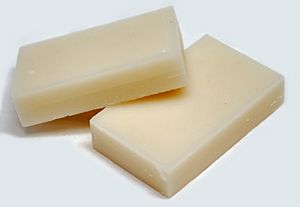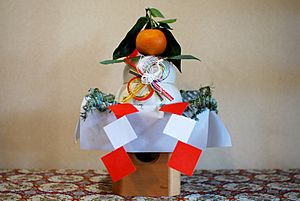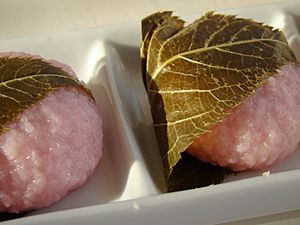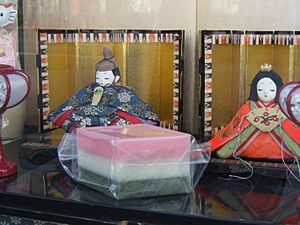Mochi (food) facts for kids
Mochi (餅, もち) is a yummy Japanese rice cake. It's made from a special kind of sticky rice called mochigome. This rice is pounded until it becomes a soft paste. Then, it's shaped into different forms. In Japan, people traditionally make mochi in a special ceremony called mochitsuki. You can eat mochi all year round, but it's a very important food for the Japanese New Year. Many people buy and eat it during this time.
Mochi is made of different things like carbohydrates (from the rice), fats, protein, and water. It has a unique chewy texture because of a special starch in the rice called amylopectin. This type of rice has very little of another starch called amylose, which makes mochi very soft and gel-like.
Contents
History of Mochi
We don't know exactly when mochi first appeared. The first time people made mochi in a mochitsuki ceremony was after rice farming began in Japan. This was during the Yayoi period (300 BC-300 AD). Back then, mochi was made from red rice. Only the emperor and nobles ate it because they thought it brought good luck.
During the Heian period (794-1192), mochi was used as an offering to the gods. It was part of religious ceremonies performed by important people. Besides good luck, mochi was also seen as a symbol for happy marriages.
People started eating mochi for New Year's celebrations during the Heian period too. The nobles believed that long, freshly made mochi meant a long and healthy life. They also thought dried mochi helped make their teeth stronger. You can even find mentions of mochi in Japan's oldest novel, The Tale of Genji.
Today, mochi is still a traditional food for Japanese New Year. A special kind called kagami mochi (mirror mochi) is placed on family altars on December 28. Kagami mochi has two round mochi stacked up, with an orange on top. This tradition was first done by samurai. Breaking the kagami mochi on a certain day symbolizes opening the mirror and ending the New Year's celebrations.
Mochi for Different Seasons
New Year
- Kagami mochi is a New Year decoration. It's traditionally broken and eaten in a ceremony called kagami biraki.
- Zōni is a soup that has rice cakes in it. People also eat it on New Year's Day. Besides mochi, zoni often has vegetables like taro, carrot, and red and white kamaboko (fish cake).
- Kinako mochi is made on New Year's Day for good luck. To make it, you roast the mochi over a fire. Then, you dip it in water and cover it with sugar and kinako (soy flour).
Spring Time
The cherry blossom (sakura) is a famous symbol of Japan. It shows that spring has fully arrived. Sakuramochi is a pink mochi with sweet anko (red bean paste) inside. It's wrapped in an edible, salted cherry leaf. This treat is usually made in the spring.
Children's Day
Children's Day is celebrated in Japan on May 5. On this day, people wish for the happiness and well-being of children. Kashiwa-mochi and chimaki are made especially for this day. Kashiwa-mochi is white mochi with sweet anko filling, wrapped in a Kashiwa oak leaf. Chimaki is a type of dango (dumpling) wrapped in bamboo leaves.
Girls' Day
Hishi mochi is a special dessert offered during the days leading up to Hinamatsuri, or "Girls' Day," in Japan. Hishi mochi is shaped like a diamond and has layers of red, green, and white. The colors come from natural ingredients like jasmine flowers, water caltrop, and mugwort.
How Mochi is Made
Traditional Way
Traditionally, making mochi was a lot of hard work. The special mochi-pounding ceremony in Japan is called mochitsuki. Here's how it works:
- First, sticky rice is soaked in water overnight and then steamed.
- Next, the hot, steamed rice is mashed and pounded. This is done with large wooden hammers called kine in a big traditional bowl called an usu. Two people usually work together. One person pounds the rice, and the other turns and wets it. They have to keep a steady beat so they don't accidentally hit each other with the heavy kine!
- The sticky dough can be eaten right away or shaped into balls or cubes.
Modern Way
Today, mochi can also be made from sweet rice flour, called mochiko. The flour is mixed with water and cooked on a stove or in a microwave. It turns into a sticky, white dough. This process is often done twice, with stirring in between, until the dough is soft and a little see-through.
With modern machines, making mochi at home is much easier. These machines do the hard work of pounding the dough for you. In factories, machines help control how chewy the mochi is and make sure all the pieces are the same size. They also add different flavors and fillings.
How Mochi is Processed
Mochi is a type of rice cake that is usually low in calories and fat. The main ingredients are rice and water. Sticky rice is the best kind to use because it expands perfectly. Other things like salt or flavors can be added for taste, but usually after the mochi is formed.
Here are the basic steps for making mochi in a factory:
- The rice is prepared, sometimes by soaking it.
- Then, the rice is dried and roasted.
- After cooling, the rice is ground into flour.
- This rice flour is mixed with liquid, like water or milk, to make a dough.
- The dough is put into machines that heat and press it. This makes the mochi expand into its shape.
- Once shaped, the mochi cakes move along a conveyor belt. Different flavors, like strawberry, mango, or salt, can be sprayed onto them.
- Finally, the mochi goes through a dryer to reduce moisture.
- In the last step, the finished mochi cakes are checked for quality, packaged, sealed, and labeled.
Keeping Mochi Fresh
For a short time, the best way to keep mochi fresh is to put it in the refrigerator. If you want to store a lot of mochi for a longer time, it's best to freeze it. Wrap each mochi cake tightly in a sealed plastic bag. Mochi can stay in the freezer for almost a year, but it might lose some flavor or softness over time.
Images for kids
See also
 In Spanish: Mochi para niños
In Spanish: Mochi para niños










